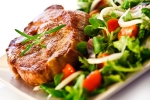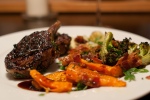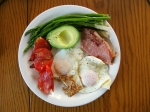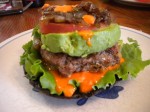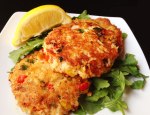When we closed our front door that evening after my husband’s friend left, I commented how maybe I should research this Paleo thing to which my husband emphatically agreed. I already knew of the Paleo diet from my research into nutrition and had seen a Paleo book lying around my chiropractor’s waiting room. But I admit I was a little unsure about it and wondered if this Paleo thing was just a fad diet. Later that evening as I typed the word Paleo into the search box on my laptop, little did I realize we were about to embark on a journey which would redefine how we both viewed nutrition and change our health in the process.
And here we are, a year and a half later, and still going strong! It’s become a lifestyle for us, just a typical way of eating and although we are not 100% we have definitely seen the benefits of eating a cleaner diet void of processed foods, grains, legumes and limited dairy.
So, let’s define what the Paleo diet is. The Paleo diet is a whole foods diet based around how our ancestors ate thousands of years ago. The idea is that primitive man, before the introduction of agriculture, had to grow, forage, and hunt and fish for his food which meant eating seasonally and using every part of the animal and fish killed. The Paleo diet most closely mimics our ancestors way of eating and is considered the ideal nutrition for how and what our bodies were designed to consume. Whole foods are necessary to properly nourish our bodies while supplying our cells with the adequate nutrients needed for optimal health and function.
So in short, these are the types of food we eat on the Paleo diet: meat, fish and eggs; non-starchy vegetables and limited fruits; raw nuts and seeds; and healthy fats such as avocados, grass-fed butter, coconut and olive oil. What we try to avoid: grains (breads, rice, oats, etc); legumes (beans and peanuts); most starchy vegetables (white potatoes, corn, peas, although we do eat zucchini and sweet potatoes); and most dairy which I’ll explain below.
Since it’s not necessary for me to reinvent the wheel — ya know, because the caveman already did that! — here are a couple good resources to further help you understand the Paleo diet:
What is the Paleo Diet?
The Paleo Diet Premise

Oh, how I hate that word — diet! It has become synonymous with losing weight through restrictive caloric intake. Just to be clear — the Paleo diet is not about restricting calories. It is a way of eating which encourages optimal health through eating whole foods including healthy fats, proteins, and carbohydrates from vegetables and fruits. So whenever the word diet is used here please understand it is used as a way to represent how to eat well without counting calories to necessarily lose weight. But if you happen to lose weight on the Paleo diet, which is often the case for for many people, then it’s an added bonus!
As as side note: I realize some people are placed on diets for health issues not just for weight loss. My studying about health and nutrition has led me to the conclusion there is only one true cause of disease — malfunctioning cells. And cells malfunction for two reasons: 1) deficiency (insufficient nutrients) and 2) toxicity (excessive toxins).* Therefore, there is only one true diet which suits most everyone and keeps our cells functioning at their optimal best to help prevent and treat disease — a whole foods diet devoid of highly processed food-like products. But more on that in a future post!
*Never Be Sick Again, Raymond Francis, M.Sc
The Paleo way of eating — see how I cleverly avoided the use of the word diet — is really quite simple once you become familiar with what foods are considered okay to eat and which ones should be avoided. Here is a chart which helped me get started:
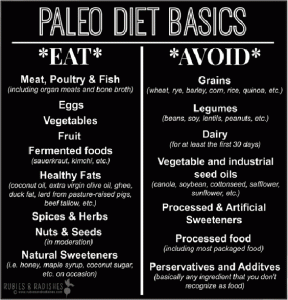
In the beginning of our Paleo venture I printed off a list similar to the one above to help remind me of what and what not to eat. This helped to keep me on track when planning menus and writing out my grocery lists. Then I scoured the internet for Paleo recipes and used those to get us going. As I said in my last post, changing to the Paleo way of eating wasn’t all that different from how we’d been eating, the biggest change came in eliminating grains, legumes including peanuts, and limiting our dairy. As you can tell, we still eat some dairy. Hubby likes a little splash of milk in his coffee, an occasional whole-milk yogurt in his lunch, and we both like a dollop or two of sour cream on these enchilada stuffed sweet potatoes. We also use grass-fed butter for frying our pastured eggs and eat cheese on rare occasions. I do very little dairy, having replaced cow’s milk with coconut milk in my coffee and sometimes in place of yogurt with berries and this homemade grain-free granola for a mid-morning snack.
While for some, this way of eating may seem restrictive, we don’t see it that way. We actually enjoy eating a fresh, whole food diet and it’s become second nature for us. Planning meals and grocery shopping comes very naturally, and cooking is a lot of fun seeing what new things I can come up with! And if once in a while we feel like eating a slice of pizza or rolling up the enchilada filling in a tortilla, then we do.
Here is what a typical day of eating might look like:
- Breakfast: Two poached pastured eggs over sweet potato hash
- Mid-morning snack: Kale, mango, pineapple, banana, coconut smoothie
- Lunch: Pesto chicken salad with carrots, tomatoes, olives, avocados, red onion, Parmesan cheese with oil and vinegar dressing; grapes
- Mid-afternoon snack: Apple with almond butter
- Dinner: Grilled fish; zucchini noodles; coleslaw; watermelon
- Late evening snack: Dark chocolate bar (I add chopped almonds to mine); tea
As you can see, eating this way does not restrict us from eating yummy food! I think we actually eat way more flavorful food now than we did before going Paleo.
So now the question many people have is why not just eat grains, legumes and dairy? Why avoid them? Well, that sounds like a great topic for my next blog post! Now that I’ve defined what Paleo is, next I’ll explain the why of eating Paleo.
Until next time…
In Good Health!


























